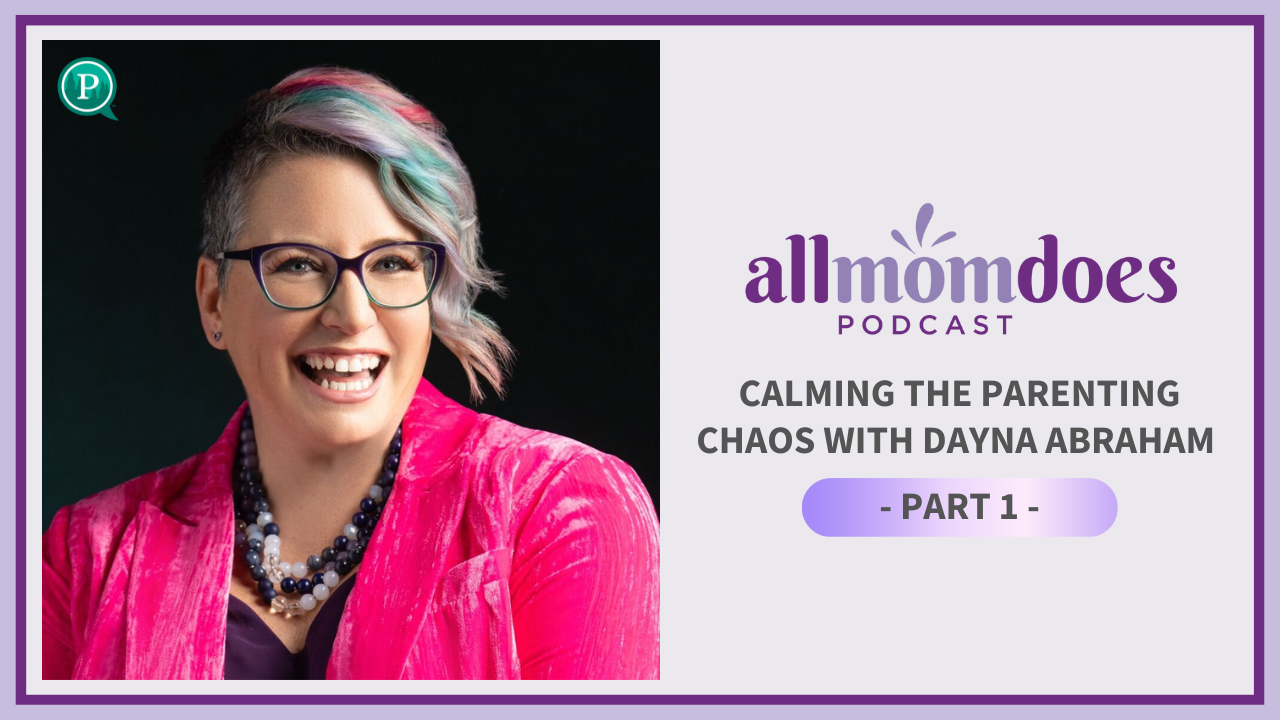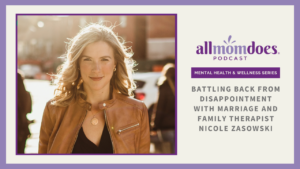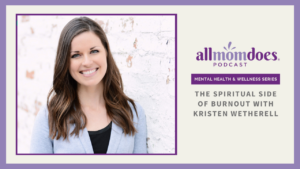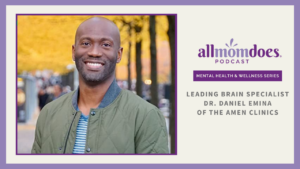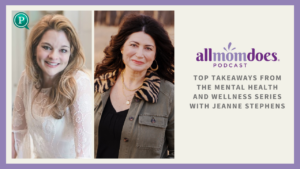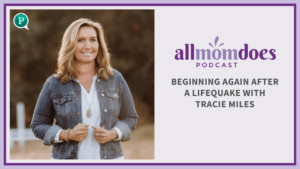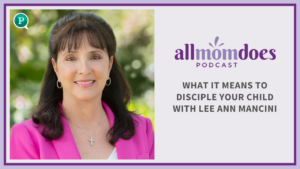Meltdowns, tantrums, behavior that gets you stared at in the grocery store…you likely have had some moments when your kids have pulled at the stops and you’re left feeling embarrassed and frustrated. What’s a mom to do? Parenting expert Dayna Abraham joins the AllMomDoes podcast host Julie Lyles Carr for an important episode on navigating your child’s behavior, whether you have a diagnosis of neuro divergence for your child or not. You’ll learn how to make a plan for when those behavior storms come and how to keep yourself calm in the middle of it in Part 1 of this two-part special interview.
Show Notes:
Find Dayna: Online | Instagram | Facebook
- Book: Calm the Chaos
Find Julie: Online | Instagram | Facebook | Twitter | Pinterest
AllMomDoes | Instagram | Facebook | Twitter
Transcription:
Julie Lyles Carr:
I’ve for sure been there. You probably have been there. This place where your kid just loses it. Grocery store, Sunday school, whatever. And you are standing there with all the clouds of feeling like bad mom just raining down on you as you’re trying to navigate both their emotional load, your own embarrassment, your own frustration. What do you do? I’m Julie Lyles Carr. I’m the host of the AllMomDoes podcast. Today I have the premier expert who’s going to help us walk through what to do when chaos is threatening or when chaos has arrived, and how to navigate that with our kids.
Dayna Abraham, thank you so much for being with me today. I can’t wait for my listener to get to hear all of your wisdom and experience and where you’ve been. So back us up, tell us who you are, what you do, all the things. We’ve given a little bit of a hint, but I want to hear from you where you live, the kids, how you got into this line of work, all the stuff.
Dayna Abraham:
Oh my goodness gracious. All right. I’m going to do my best. So I’m Dayna Abraham and I’m the founder of Calm the Chaos Parenting. And that started 10 years ago as a blog, Lemon Lime Adventures, which has now had over 41 million visitors in the last 10 years. And over the years, I have helped parents and caregivers be able to create better relationships with their kids no matter how challenging the situation is. And I got into this work. I am a mom of three kids myself, all neurodivergent, all unique themselves. I have a daughter who’s 10, a boy who turned 16, and my oldest boy just turned 18. And it all kind of started, I like to joke, I was kind of born into it. So my oldest brother is bipolar. And so growing up, none of us knew what that was.
And so I received kind of the end of all of his explosive meltdowns, the punches, the hits, the scratches, all of that. And so I had to learn really early on how to handle what I call storms, these big tornado storms of behavior. And so when I became a teacher, my favorite kids were those kids, the ones who the other teachers deemed as too much or not enough. They came with a paper trail behind them. And I taught in the classroom for over 12 years in inner city Chicago and absolutely loved everything about it, especially those harder kids. And so when I became a parent, I was like, I got this thing in the bag. I am going to be the best parent in the world. Someone’s going to show up at my doorstep with an award and flowers, and they’re just going to parade me around town and say, this is the best parent ever. That never happens.
I know. Where are the sound effects? That never happened. Instead, I was handed an amazing child, but a child who was here to teach me all kinds of things about what I thought I knew about parenting, about behavior, about relationships, about child development. And so I went on this journey of trying to understand him, and by the time he was in second grade, he was being kicked out of school more days than he was in school. And there came this day where the principal gave me two options and she said, “You can either let this officer take your son into custody or you can take your son home and don’t bring him back until you figure out what’s wrong with him.”
Julie Lyles Carr:
Wow.
Dayna Abraham:
That was kind of the moment that I knew things had to change. And so that was 10 years ago, and I’ve just been trying to figure things out and iterating and navigating and trying to find a path forward that’s sustainable even in the hardest times.
Julie Lyles Carr:
Right. You bring up this term neurodivergent, and a lot of us are hearing it more and more these days. Now, some of us may harken back to watching some series about being divergent in that realm. What that means is you have the strengths of all of these amazing type of capacities and on and on when we think about the book series and the movie that came out. But as we talk about being neurodivergent, it feels like some ways, Dayna, that everybody’s claiming to be neurodivergent. And then there are other more classical definitions of what that means and things that people need to be looking for. How do you look at this term?
Dayna Abraham:
Yeah, so 10 years ago when I was first starting out, this wasn’t a term that most people knew. And I would say even just like three years ago, it wasn’t a term that was widely used. And so I use it sparingly because I know that not all people understand this term, but the idea behind neurodiversity has been around for a long time. And the idea is that we all have different brains. That’s the idea behind it. And that we have, there are some people who are neurotypical, so that means that they’re developmental milestones, they’re hitting those, they are kind of ticking along the path the way that the average bear would, the norm.
And then you’ve got those that mess up the bell curve. It’s like outliers. And those are people that are considered neurodivergent. Their brain is wired differently. They think differently, they act differently. A lot of times that means that there is a diagnosis attached to that autism, ADHD, anxiety, OCD, bipolar disorder, whatever that is. There’s so many different variations of how brains are wired and how we all work. And the beauty of neurodiversity is this understanding that we’re all unique and that there isn’t one path that’s right for all of us.
Julie Lyles Carr:
And yet we have a culture. We have a society that really expects people to walk down a certain line, and we put a whole lot of value and moral value around that. Our classrooms are not really built and understandably so, but they’re just not built for people who may not be the average bear. Different experiences that we have. Everything from needing to sit in an airplane for a certain amount of time to being quiet during a movie, to how it’s expected you will behave in a restaurant. All of those kinds of things can really create some huge hurdles for someone who is wired differently. When did you begin to notice in your son, “Huh? He is marching to a different beat.” When did that first start emerging for you?
Dayna Abraham:
That question’s so interesting for me because I didn’t realize until much later in life how in tune I am with other people. And I think that’s one of my superpowers is I understand people why they do what they do without really realizing the science behind it yet. And so when he was born, I think I was a really in tune parent. And I’m not saying that to pat myself on my back. I’m saying that because it wasn’t that hard to me. Now, my mom used to say, “You stick to a strict schedule. You need to try to get him off that schedule. It’s okay if you leave the house at this time. It’s okay if he doesn’t wear those clothes. It’s okay if he doesn’t do these things. It’s okay if he eats this food.” And I knew that I had tried it once or twice and it went horribly wrong.
Julie Lyles Carr:
Disaster. Yeah,
Dayna Abraham:
It was a disaster. He either didn’t sleep through the night or he was super cranky or whatever. So I was really particular in our environment for those first two years for sure. And we had a very set regimen, a very set routine because that’s how he thrived. Now, once we started inserting him into the school system, that is when we started really noticing he was struggling more than other kids. And this was me as an educator too. And so it kind of surprised me. I mean, he was highly verbal. So at one he had over 100 words by two, he was speaking full sentences and he had more words than you can even calculate. And so it hid a lot of things because he could communicate what he wanted, what he needed. He potty-trained himself, got out of diapers at eight months old, nine months old, something crazy like that.
And it was because he didn’t like being wet. I didn’t know that at the time. I didn’t know that he had sensory preferences and that he had sensory processing disorder at the time. So when I think back, when did I know, I probably knew all along, but I didn’t actually start paying attention to it and trying to figure it out until he went to preschool and got kicked out. He went to kindergarten and he was always in trouble. He was in first grade and he was crawling on the floors and he was always sent to the principal’s office. And once the suspensions kept happening, then it was like, okay, what is going on here? What is going on that’s making this so hard for him?
Julie Lyles Carr:
How do we distinguish, and this is a really tender spot, the difference between a kid who is doing the best they can in an environment that is not exactly conducive to how they’re wired, and they’re trying to work out some of their own jitters and needs and all of that kind of stuff in a form of advocacy that can be very distracting in a form of advocacy for themselves that can absolutely throw things off track for the other kids in the room. How do we distinguish between that and a kid who is acting out and maybe we put terms around it like they’re just being defiant or they’re being the rebel, or maybe they’re an eight on the Enneagram, whatever it is that we put into that, kind of look at that kid. How do we understand the differences?
Because since your drumbeat is about how to deal with chaos, there are environments where even a kid who’s been diagnosed very specifically, they may be bringing the chaos, and then there are kids who are bringing the chaos just because kind of fun, and they just don’t feel like doing what people are telling them to do. Or at least that’s the way we usually look at it, right?
Dayna Abraham:
That’s the way we usually look at it.
Julie Lyles Carr:
So how do you navigate all that? Break that down for us.
Dayna Abraham:
I might make some enemies here. Frenemies,
Julie Lyles Carr:
Frenemies, frenemies.
Dayna Abraham:
I actually don’t think it matters if we distinguish, and here’s what I mean by that. I think if we approach children and adults as they’re doing the best they can, and there is a reason behind the behavior, there is a reason this is happening, how can we figure out what that is? How can we create an environment where they can thrive, where we can thrive together? Then I think we’d have a very different world then if we already assume they’re doing this just to cause trouble. They’re doing this just to get their way. They’re doing this just because they don’t want to. Well, why don’t they want to? Why are they wanting to get their way? What is under that? So there’s this, and I’ll try to keep it really quick, but when my son was 11, he was put in residential treatment against my will.
So they took medical power of attorney over him and were going to put him into a residential treatment unless I agreed. And so I said, okay, I’ll agree as long as I get to kind of say I’d like him to go somewhere that understands sensory. And so they asked me, is he autistic? And I said, “No, he has no diagnosis at this point. However, these are his challenges.”
So he ends up at this place that has a wing for children who are already diagnosed and a wing for children who are behavior problems. And when you go up to the reception area, you get out of the elevator and it’s a wing to the right and a wing to the left. And my son luckily made it to the wing to the right, and he was treated as if there was a solution, as if he wasn’t trying to do this on purpose, as if there was something going on and there’s a different system that needs to be figured out for him. And then on the other side, you have these children and they were treated as if were the problem. And many of those children then went on to get kicked out of their house, went on to be in juvenile detention centers, went on to go to jail. Their trajectory was wildly different because of how their behavior was seen.
So that’s where I get that innate like, no, no, no. Let’s take a step back and let’s look at this differently.
Julie Lyles Carr:
And part of what I think comes into play on this is that when we are so focused on behavior, ironically, I mean we’re focused on behavior without a why. And it’s very easy for us to veer into the lane of putting a moral code around it. And that’s not to say there shouldn’t be moral codes around things. We’re not trying to just bail out on that completely, not at all. But that place of starting first by seeing it that way, instead of seeing potentially the behavior as a coping mechanism for something that’s going on is a place where a lot of us can really have a miss. And it can be easy for us to look at some of those behaviors and simply want the behavior to stop just what is the most efficient, most effective way to get the thing to stop. And we’ve all been there, the grocery store aisle where the kids freaking out.
And of course there’s always that one, Dayna, there’s always that one woman. Why are we not as a tribe of women helping support each other in those mommy moments where things are just spinning out, but there’s always that one tsking or doing whatever she’s going to do. And we begin to take on that sense of, I got to figure this out fast and I’ve got to come up with the fastest way to get us around this behavior. Now, I will say too though, Dayna, I feel like we’ve talked about this definition of neurodivergence. I feel like I’m hearing more and more people use those terms, and I think some of those people are using those correctly, if I understand your definition of it. Are we seeing more kids who are being identified as having this different way of thinking, this different way of navigating the world, a different way of taking an input?
Do you see, is that just because we have more of a diagnostic cycle that’s gearing up? Do today’s kids simply, are they just more challenged with it? Because I will say, I’ve heard people say about previous generations of kids, and when I think back in my own childhood, I don’t necessarily think they’re wrong who are saying, man, back in my day, kids just didn’t seem to be having some of these same issues. We just did the deal and you did the thing and maybe once every few grades, you might have a kid in your class who was really acting out, but it just wasn’t that common. So how do you see the balance there between today’s more verbal and accommodative environment for kids who do seem to have a level of neurodivergence versus people who were like, well, back in my day, we didn’t ask anybody why they felt the way they felt. We just expected this and they did it. Bridge those two things for me.
Dayna Abraham:
I think it’s a kind of a double-edged sword here. I think that yes, we are seeing more and more children who are struggling or who are neurodivergent and they’re diagnosed with different diagnoses. And part of it is because there is more awareness, there is more acceptance, there is more diagnostic tools. We know way more just in the last 20 years about brain scans and about child development and around the effects of behavior modification on children and as they grow up. And so we know so much more now than we did when we were growing up. And in turn, I would also say that those kids were still there when we were growing up. I was one of them. No one ever would’ve said, “Oh, Dayna should have a diagnosis”, because I did a lot of what’s called masking. And I knew my mom had her hands full with my older brother.
And so I needed to be the good kid. I needed to be the one that got the good grades. That made my mom proud, that did all the things. But yet I struggled. I struggled a lot. I struggled to keep friends. I struggled with my emotions. I struggled to feel like I fit in. Now as an adult, I know that I am what a lot of people would call twice exceptional, which means that you’re gifted, have a high IQ, and you have another neurodivergence. So ADHD is mine and anxiety. Those all kind of co-gravitate together for me. And so now when people meet me as an adult and they’re like, oh yeah, not surprised that you are an ADHD adult, and it’s like, but growing up, no one would’ve claimed that. And when I look back, I can remember one kid or this kid or that kid and that’s it, who they were so far outside of the norm of the classroom that maybe you’re like, Hmm, what’s going on there?
But I think the more we know is that it doesn’t have to be so far to the right or to the left of appearances. And you can still have a child who thinks differently, who’s wired differently, who struggles with sensory input, who struggles with feeling safe or has a trauma response or isn’t attached. And there’s so many different things that could be under the surface. And so I would just say we were already here and there are lots more ways to accept and understand that.
And then the last piece I want to add is I do think that there are more children struggling. Very typical, “typical” children are struggling right now because as a collective, three years ago, it’s not that long ago, we all went through a year and a half of uncertainty and isolation and disconnection. And so we’re not that far out of the woods.
And many of our children, it was in their most vital developmental stage that they were isolated, that they were unsure of what was happening the next day. And there’s a lot more cultural divide right now that they’re having to navigate. They’re seeing a lot more. They’re not working on farms anymore. They’re not walking to school both ways uphill in the snow. And so life has changed, and that is going to affect how they interpret the world. That is going to affect how sensory overwhelmed they are, their anxiety levels, their worry, their sense of safety. And so we are going to see an increase of behaviors.
Julie Lyles Carr:
We’re going to be unpacking the impact of the pandemic and lockdown for a long time I think as sociologists, as psychologists, as we continue to try to figure out exactly what that all meant long-term.
In the short term, what was fascinating for me, Dayna, is that for several of my kids, I had three or four who were already pretty much launched, and then we had the rest of them still in the home and doing all the things and navigating all the weird, what I didn’t expect was as things began to open back up, a couple of my kids would go into total vapor lock. A couple of the kids, I would’ve told you were some of my most social, when they needed to order a coffee from Starbucks or ask a question at a grocery store to find an item, this turned into total torture, and I could not figure it out. We’re still kind of unpacking this anxiety monster that showed up, even though nobody would’ve verbalized it that way. It was almost like because they missed the experience, the onboarding experience developmentally at a certain critical time because we were in lockdown that then when they needed to start bringing those skills to the table, wow.
Dayna Abraham:
And it’s so common. You’re not alone in this. I just had a good friend, I was on a trip and he was like, he’s got an incredibly bright young girl. She’s 12. He’s like, suddenly she’s getting so much anxiety over when things are out of her control. And I’m like, well, that makes a lot of sense. So I would encourage creating a safe place for her, creating an in the moment plan for when she feels that way and a way for her to verbalize, “I’m not feeling safe right now. I feel like I need some control. What are some things I can control in this moment?” And the more aware we are as parents, the more we can support our kids in that.
Julie Lyles Carr:
You bring this up, this idea of the difference sometimes between boys and girls and how we perceive some of these behaviors and how effectively you were able to mask. I’ve been seeing more and more, reading, more and more about this, about girls who are seen as really seeming to navigate the classroom fine and different situations just fine because they are able to act in the way that we expect. They’re not acting out in more aggressive ways. And so we have a generation of girls who now entering the college years, their twenties, et cetera, are saying, “I was riddled with anxiety the whole time. I was riddled with the burden of feeling like I had to be the good kid or what was expected.” What’s your perspective on some of these gender differences when it comes to neurodivergence in the way that sometimes that’s expressed and the expectations of how we navigate that depending on if our child is a girl or is a boy and is exhibiting some of these behaviors or isn’t exhibiting some of these behaviors and we need to be on the lookout, how do we do that?
Dayna Abraham:
So I’m a big believer in breaking boxes. And so yes, it is very common in children who are, or humans who are neurodivergent and also a girl is very different than neurodivergent boy. There’s a lot of studies. The brain is wired differently, the symptoms look different or the characteristics look different. But I’d like to remove that box just a little bit and say, how can we support our kids no matter what we’re seeing, if we’re not seeing or we are seeing these struggles per se, they’re coming out on top kind of exploding like we see in the “typical boy behavior” of being super active and super touchy and blurting things out and not really staying focused and being disorganized or those what you described of, I’m going to be the good girl, I’m going to do what I’m asked, but I’m also going to be riddled with this anxiety on the inside.
I think the common answer and solution here is that we start at a very early age, and it’s never too late if you’re listening to this and you have a 17-year-old, but we start by understanding where does behavior come from? And we’ve unraveled that there are six core basic needs that are missing from behavior, and that can also be shut down. So a behavior can be shut down, it can be running away or hiding. It can be placating or kind of pleasing. So if you have a child who’s always pleasing and always doing the things that they’re being asked, I would take a second look at that and say, okay, why are they so pleasing? Why are they so compliant? What could I be missing? And where are they doing that when they don’t actually actually feel comfortable? And then you have the fight response, which is the one that gets all of our attention the most, right?
That fight response is where kids are going to push down their heels, where they’re going to kick or hit or yell back. My mom and I had a volatile relationship growing up because we were both fighters. Our stress response was both just a fight. My husband, he shuts down and walks away. My son shuts down. My older son, he’s a fighter. My daughter, she just freezes for a minute and then she fights a little. It’s kind of a combo, but knowing that is incredibly important. And then once we know that we can start identifying it, start sharing it with our kids. They can become self-aware. And so giving them a safe place to make mistakes, to be themselves, to show up as they are and help them make sense of the things that are happening. Then when they go out in the world, they will know how to advocate for themselves in a way others want to listen. Instead of the I told you this, or I’m not doing that, or keeping their mouth shut.
Julie Lyles Carr:
Right. Now, I can already hear the question, the echo coming from a potential listener, which is this, well fine then Dayna. So I begin to create this environment in my home that honors how my kid is wired and helps them navigate around some of these things that are triggers. But there’s this world out there that is not going to care that they might be feeling a little hungry or the lights might be a little too bright, or that level of noise doesn’t work for them or whatever the thing is. How on earth am I supposed to prepare a kid to go into that world? I can curate this world all kinds of ways. How do I prepare them to go into a world that is not going to be willing to do that for them?
Dayna Abraham:
So in the book, I actually talk about seven of the like, “Oh my gosh, my kid’s going into the real world”, fears that we all have. But number one is that it’s not sink or swim unless you’re dealing with an 18-year-old maybe. But even then, I have a son who just turned 18 and 18 is an arbitrary number. His struggles do not go away because he just had a birthday and blew out 18 candles. He is still the same kid he was last week, and so he might take a little bit longer to go out into the “real world”. So that’s number one. It’s not sink or swim, and it’s not today. You don’t have to send them out there today. But the big thing that I want to really impart is by creating a space at home where they can feel seen and heard and valued, you’re also creating a space where you can guide and mentor. And that’s the key is in the moment you’re there to hold space, you’re there to support, you’re there to help.
And then afterwards, when everyone’s calm, when everyone’s receptive, then now you can start coaching building skills. You can start having conversations problem solving. So that might sound something like, “All right, remember yesterday when you were really upset and you threw your controller across the room and that was really hard? Now I understand that that’s your go-to move right now, and I’d like to work on helping you create new ways of handling that frustration. Now, I also know that if you do that in your classroom, you’ll probably get in trouble. And if you do that at Walmart, the store might call up, take us back and call the police on us.”
And so talking about what does this look like in different scenarios when you do this and what are alternative plans for when you’re out in public and this happens, what are alternative plans when you’re stopped by a policeman when you’re 19 and you’ve been driving really fast because you’re going to be late to work, do you argue with them and tell them you were going to be late to work? Or do we role play what that would look like so that the police officer is able to hear what you’re trying to say and you’re able to get through and take the ticket if you’ve got to take it and then move on.
Julie Lyles Carr:
Right. I think that role playing is really powerful to help someone connect the dots between how it works here and here’s a safe space to express. But that doesn’t mean we just leave it there. I think that’s the missing link is sometimes we can hear information about accommodating for someone who is wired in a way that these things are triggering, these things are challenging, and we think that it means that now our job as a parent is to try to remove any of that kind of stuff. Instead of saying, no, let’s talk about when, when it happens. Here’s the way you’re responding here. Here’s a way you need to respond there.
This conversation with Dayna is so great. We just kept rolling. So this has been part one, and you’re going to have part two next week where we come back with Dayna and we discuss more about how to deal, what to do when you are parenting a child who has some really complicated big emotions, who is bringing some chaos to your life, what you can do as the mom to change that conversation, to change that environment, to help your child navigate those kind of challenges.
Be sure and check out AllMomDoes, allmomdoes.com, AllMomDoes on the socials. I’m Julie Lyles Carr, all the places. I’d love to see you too, particularly on Instagram. And be sure and grab the link and share this episode with someone who you know is struggling, feeling alone in navigating some complex emotions with their kids. So be sure and share that. That is one of the greatest thank yous you can give us. And I’ll see you next time for part two of this special conversation with Dayna Abraham.
Follow this podcast:

